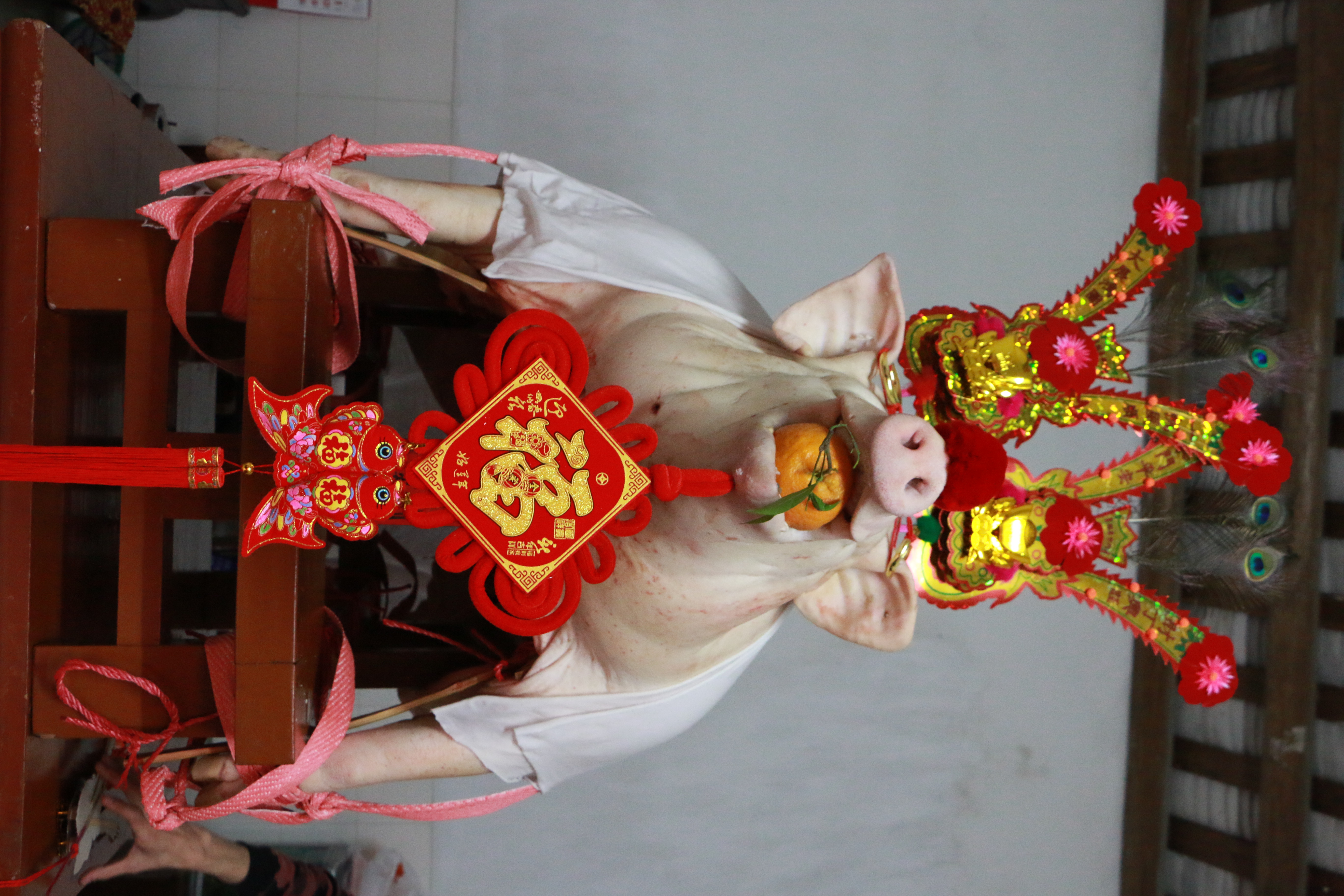
装饰大猪
Decoratethe Pig
总述
中国历史源远流长,民俗活动更是精彩纷呈。中国潮汕、闽南一带都有“赛大猪”的民俗活动,潮汕地区是“赛大猪”的起源地,以汕头地区最为出名。“赛大猪”是一种民间庆丰年的仪式,有着五谷丰登、六畜兴旺的蕴意,加之“赛大猪”的方式有着促进生产、繁荣经济的积极意义,因此在潮汕地区的举办仪式十分隆重,场面壮观,成为远近闻名的一大盛事。
相传汕头市月浦社区的“赛大猪”源于明代。那时潮汕地区常常发生鼠疫,村民便把大猪作为祭品,祈求除厄运,保佑平安。值得一提的是,除了普遍意义上的祭拜祈福外,“月浦赛大猪”还是当地年满 24岁的男青年(方言称“丁头”)的成人礼——俗称“出丁头”,意味着即将出人头地,因此具有更鲜明地域性的特色传统文化。深入研究该民俗活动,进而明确其具有的民俗价值与文化意义,有助于传承与发展我国的区域文化。
时代在进步,古老的民俗文化也在“与时俱进”地简化甚至消失。特别是在2020疫情爆发以后,聚集性的民俗活动大量减少,“赛大猪”活动也沉寂了三年。这就更加凸显出民俗摄影的重要意义——历史记录与文化传承,提供宝贵的影像资料,让后代的考究有迹可循。
本作品摄于2019年,实录了“月浦赛大猪”的过程,从前期的供品准备到仪式的正式开场与收尾,还原当时民俗活动的现场。同时通过对当地百姓的采访,解读民俗活动背后的历史含义,讲好潮汕故事,弘扬中国文化。
前期供品准备
大猪是本次民俗活动的重头戏,一般称之为“丁头猪”。人们通常会在一年前开始精心饲养这头钦定的猪,并且要专人在本地饲养,要让它吃好睡好。谁家的猪越肥美,暗示着谁家的家底财力雄厚,有着浓重的农耕文化氛围。
每一头丁头猪都要精心打扮才能登场。猪屠宰完后,剃去猪毛,但留下猪背及尾巴上的毛做装饰,然后开始给猪“化妆”,梳理整齐,染上红色。白净的猪身上贴着精美的红色剪纸图案,挂上吉祥的红灯笼或福气,口含大桔子或石榴,意喻大吉大利,多子多孙。最后摆放到用木头和竹片捆绑而成的定制猪架子,加以固定。此外还有一只精心打扮的羊披在猪背上,俗成“全副猪羊”。这一过程极大地体现了潮汕人民对未来的美好愿景,传承和弘扬了中国古老的手工艺术。
鸡、鸭、鹅、鱼是潮汕祭祀中必不可少的。“赛大猪”仪式中,每一样供品都有它特定的造型。例如,鸡定是要站着固定,意味着鹤立鸡群,出人头地的美好祝福,非常考究。
粿品是一种潮汕美食小吃,也是供品之一。潮汕粿品种类繁多,因不同节庆而变换。赛大猪民俗中,主要有较为常见的红粿,以及只用于赛大猪祭拜仪式的面前粿。在做粿的流程中,人们往往分工明确:女性负责制作小而精的红粿,男性负责做高而大的面前粿。男女分工在农耕文化中也反映了社会角色和责任的差异。
正式开场
月浦赛大猪一般分为两场,一场在大年初七晚 7点到 12点,另一场在初八早上 4点到 7点。这是由于全乡每年都有几十人甚至上百位男子年满 24岁,而摆大猪的场地有限,所以要早早分批并抽签定位置。“丁头”的人数也从某种程度上体现了该地区人口的出生率。据了解,“丁头”的人数正逐年减少,与现阶段社会老龄化的形式趋同。
拜老爷——“老爷”是潮汕人对神仙的称谓,是一种神圣信仰。赛大猪敬奉的神明尊称为“太保爷”。正月初七初八这两天,“丁头”及其母亲都需要来行大礼,祈求平安顺利,心想事成。
赛大猪——正月初七晚,做“丁头”的家家户户都陆陆续续地来到太保爷宫前的大埕,将准备好的供品整齐地摆放在指定位置的八仙桌上。“赛”的内容主要有二:一是比比谁家的猪更大,二是比比谁家抬猪跑得快。这是此民俗活动最为精彩的部分。
时辰一到,组委会点响三声炮,各户马上抬起自家的大猪,往自家飞奔而去,像抢东西一般地把大猪快速抬走,看谁跑得快。但跑的过程也要格外小心,不能掉东西,否则不太吉利。这个时候都可谓人声鼎沸,场面尤为壮观。
一头四五百斤的大猪往往需要七八个大汉才扛得动,他们在围观村民的呐喊助威声中狂奔。谁家的大猪“跑”得快,寓意着新年家庭和睦,人丁兴旺。跑得快还意味着这家人身强力壮。在农业社会的历程里,强壮勇猛是合格男丁的标志。
诵经文——正月初八一大早,所有的“丁头爷”都要前来,集中盘坐在宫前接受经文的洗礼,保佑“丁头爷”们幸福平安,万事顺意。至此,成人礼顺利完成。
结语
月浦赛大猪成人礼,作为一个长达千百年的村落民俗活动,是村民们创造、共享、传承的风俗习惯,寄托着五谷丰登、兴旺发达的美好愿望。它是老百姓长期生活实践中创造和积累的文化,记载着一个历史时期的文明脚印,是不可多得的非物质文化遗产。在时代快速发展下,很多繁瑣的传统文化习俗正在不可逆地消失中。文化的消亡,是历史记忆的丧失,将是人类文明的一大损失。拍摄纪录,搜集整理和抢救中华民族的民俗文化遗产的行动迫在眉睫。这让我更坚定了民俗摄影的重要性。
Overview
China has a rich history and its folk activities are incredibly vibrant. One renowned folk activity in the Chaoshan area is called"Sai Da Zhu," which serves as a coming-of-age ceremony for local young men who have reached 24 years of age. It also symbolizes good harvest and prosperity. Unlike animal races such as horse or dog racing,"Sai Da Zhu" involves comparing which household raises the largest and fattest pig. The competition aspect lies in carrying the pig and running faster with it. In ancient times, this method had a positive impact on promoting production and economic prosperity, making the ceremony held in the Chaoshan area highly significant, grand, spectacular, and widely recognized.
The"Sai Da Zhu" festival takes place in Yuepu Village, Shantou City within the Chaoshan area. Its origins can be traced back to the Ming Dynasty when plague outbreaks were common in this region. Villagers would sacrifice pigs to pray for good luck and peace. Over time, it evolved into a coming-of-age ceremony for local youth known as"Ding Tou" in dialect terms. Conducting an extensive study on this folklore activity will further elucidate its cultural significance and folklore value while aiding in preserving and developing Chinese regional culture.
With societal progress comes simplification or even disappearance of ancient folk culture; especially after the outbreak of COVID-19 pandemic in 2020, gatherings for folk activities significantly decreased resulting in cancellation of the"Sai Da Zhu" event for three consecutive years. This emphasizes further importance of folk photography - serving as historical records that contribute to cultural inheritance by providing valuable visual data for future generations' research purposes.
This work documents the process of"Sai Da Zhu."
These photos were taken in 2019, documenting the entire process of"Sai Da Zhu" in Yuepu Village, capturing the preparation of offerings and the opening and closing ceremonies, thus recreating the authentic atmosphere of these traditional folk activities. Additionally, by conducting interviews with local residents, we delve into the historical significance behind these customs, thereby enhancing our understanding of Chinese culture.
Preparation of offerings
The highlight of this folklore activity is the magnificent"Dingtou Pig", which symbolizes prosperity. People start raising this special pig a year in advance, ensuring it receives proper care and attention from a dedicated caretaker. The strength of one's pig reflects the financial resources of their family, showcasing a thriving farming culture.
The pigs are carefully dressed up before they appear on the stage, with their hair shaved off after slaughter except for the back and tail, which are left for decoration. Then, they undergo a"make-up" process of neat combing and red dyeing. The white pigs are adorned with exquisite red paper-cut patterns, auspicious red lanterns, and hold big oranges or pomegranates in their mouths to symbolize good luck and prosperity. Finally, they are fixed onto custom-made pig racks made of wood and bamboo pieces. Additionally, a sheep is carefully draped on the pig's back, known as the"full pig and sheep". This entire process beautifully reflects the Chaoshan people's hopeful vision for the future while preserving China's ancient handicraft art.
The presence of chickens, ducks, geese, and fish is essential in Chaoshan Worshiping. During the"Sai Da Zhu" ceremony, each offering has its own distinct shape. For instance, the chicken must be standing upright to symbolize standing out from the crowd and being visibly superior, which adds an element of sophistication.
Chaoshan rice cakes are also included in the offerings. There is a wide variety of Chaoshan rice cakes, which vary according to different festivals. During the process of making rice cakes, there is often a clear division of labor: women take charge of crafting delicate red rice cakes, while men are responsible for creating giant white rice cakes. This division of labor between genders also reflects distinctions in social roles and responsibilities within farming culture.
Official opening
The"Sai Da Zhu" Festival is typically divided into two events: one on the seventh day of the Lunar New Year from 7:00 a.m. to midnight, and another on the eighth day of the Lunar New Year from 4:00 to 7:00 a.m. This division is necessary due to the large number of 24-year-old men in the village each year and limited space for displaying the big pigs. The annual count of youth aged 24 also reflects the population's birth rate in this area, which has been decreasing over time, aligning with society's current aging trend.
Worshipping deities is an integral part of Chaoshan people's cultural spirit. On both the seventh and eighth days of the first lunar month,"Ding Tou" and his mother dress in red attire as they perform important rituals and pray for peace and success.
On the seventh night of the first lunar month, every household neatly places the prepared offerings on the table at the designated location. The main highlights of"Sai Da Zhu" festival include comparing whose pig is larger and determining who can carry their pig faster. This thrilling aspect adds to the excitement of this cultural event.
When the time comes, the organizing committee fires three cannons, and each household immediately carry the pig and run towards their home to see who can run faster. They need to be extra careful while running and don't drop anything. Otherwise, it means bad luck. At this time, it was full of people and the scene was particularly spectacular.
A large pig weighing four to five hundred pounds often requires seven or eight strong individuals to carry it. They ran wildly amidst the cheers of the spectators, believing that the faster they run, the more harmony and prosperity they will receive in the New Year. Throughout history, strength and bravery have been considered essential qualities for a capable individual in agricultural society.
On the eighth day of the first lunar month, early in the morning, all"Dingtou" will gather and sit cross-legged in front of the palace to receive the sacred scriptures and offer blessings for a better future.
Conclusion
The"Sai Da Zhu" Coming-of-age Ceremony, as a traditional rural activity, has endured for millennia and embodies the aspirations for bountiful harvests and prosperity. It represents the cultural heritage forged and accumulated through generations of people's lived experiences, documenting the imprints of civilization during a specific historical era. This intangible cultural heritage is truly precious. However, with the rapid advancement of society, numerous intricate traditional customs are regrettably vanishing beyond recovery. The decline of culture signifies the erosion of historical memory and constitutes a significant setback for human civilization. The imperative to photograph, collect, organize, and preserve the folk cultural heritage of the Chinese nation has become increasingly urgent. This experience has further reinforced my conviction regarding the paramount importance of folk photography.
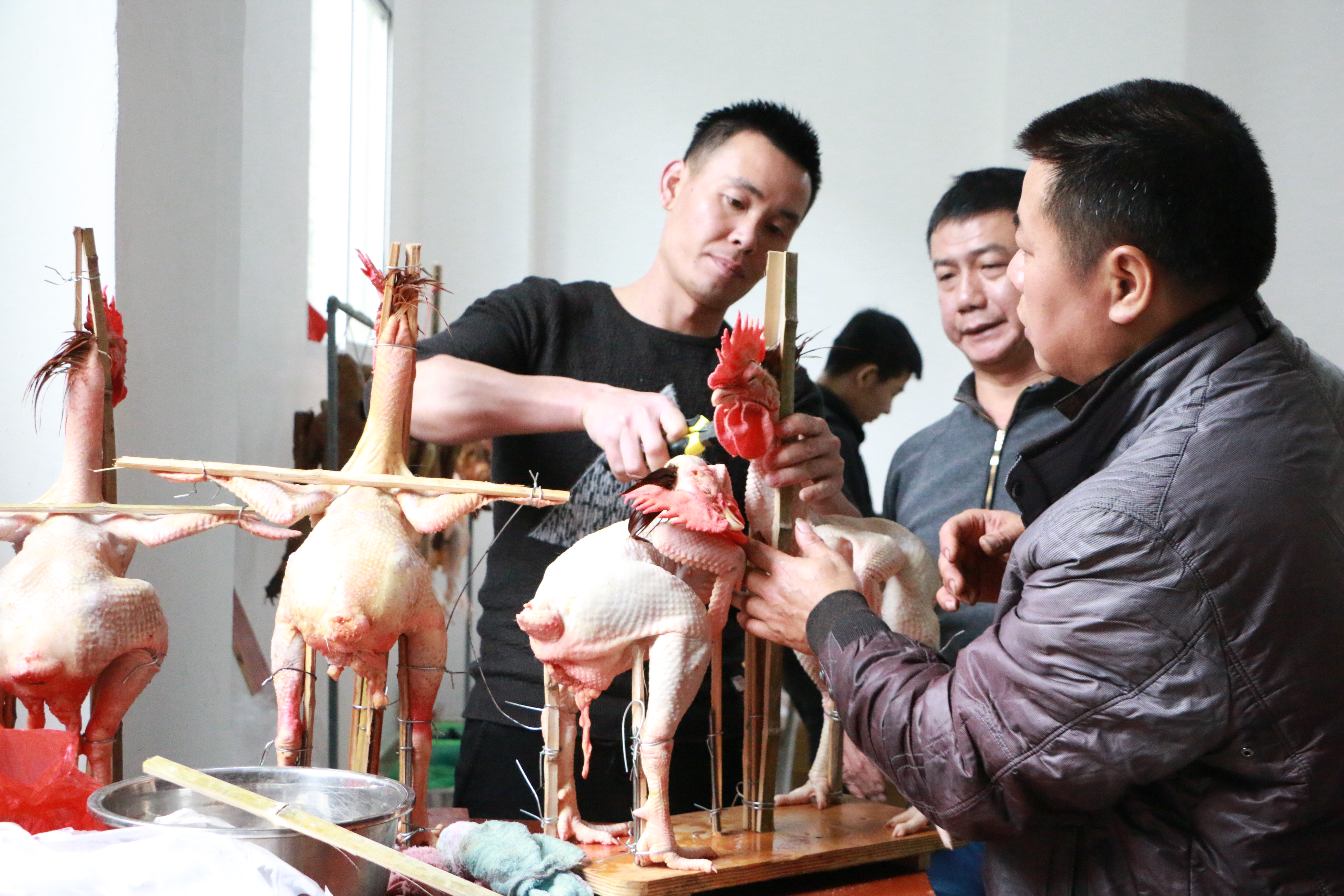
鹤立鸡群
Style the chicken
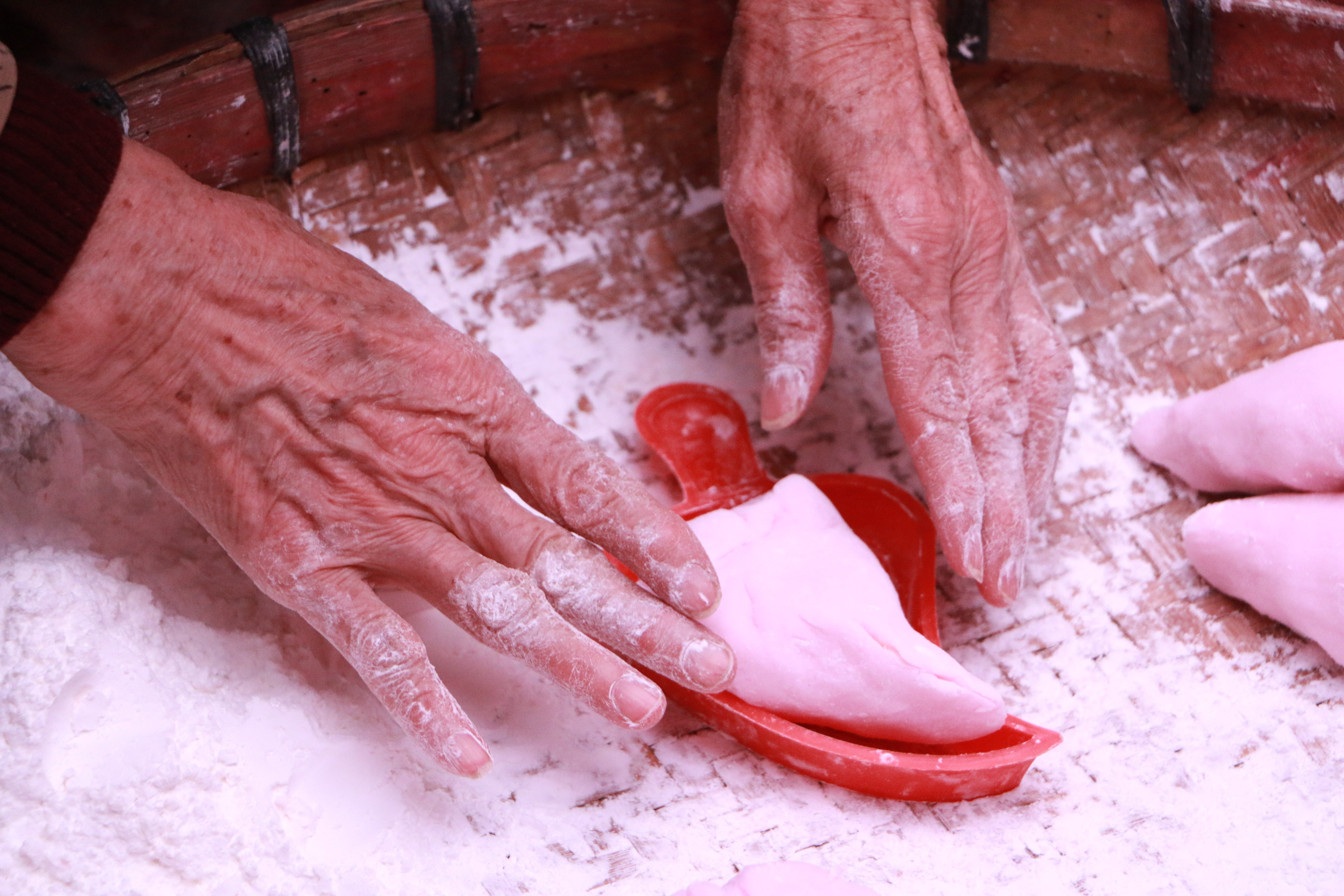
制作粿品
Make Rice Cakes
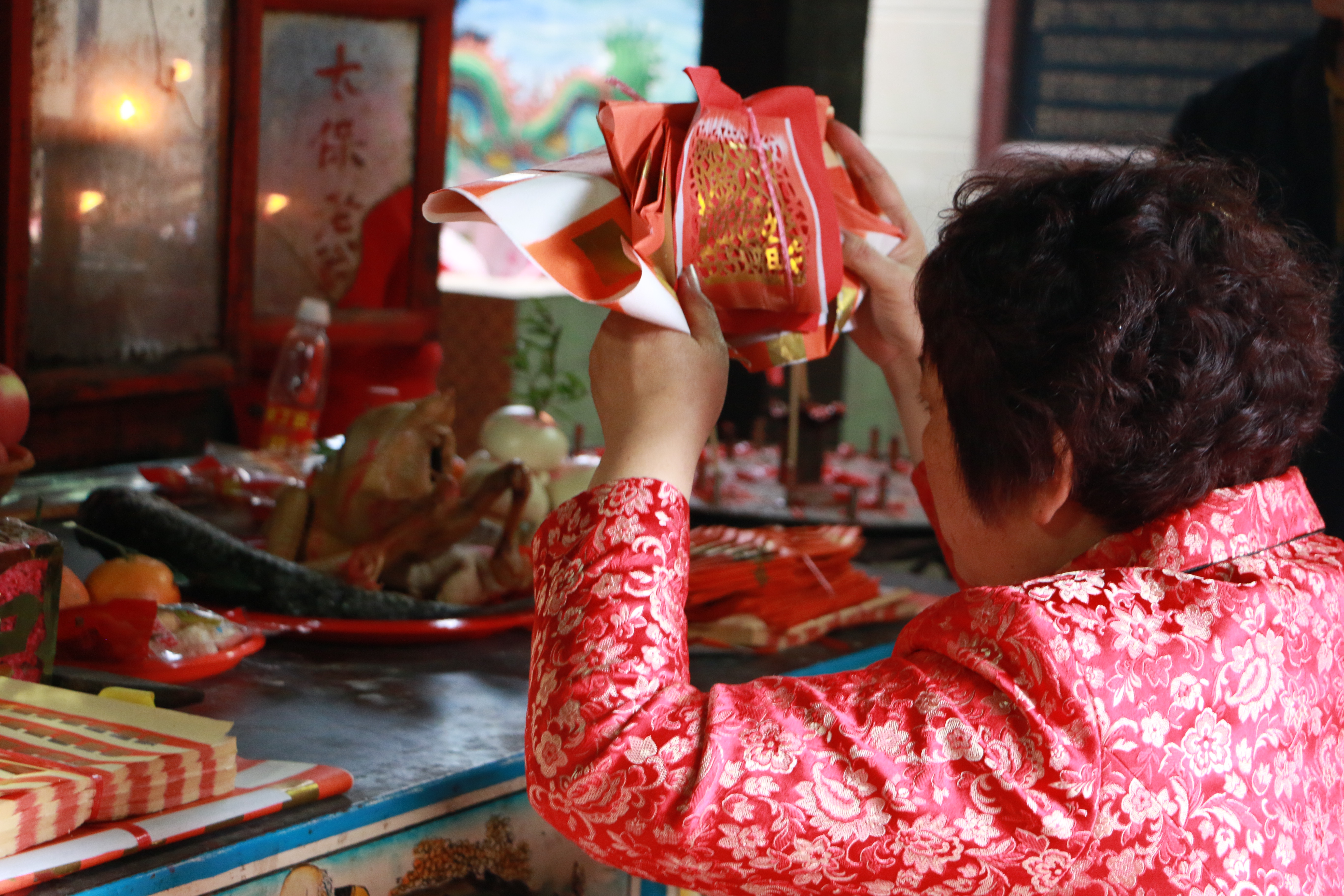
拜神
Worship
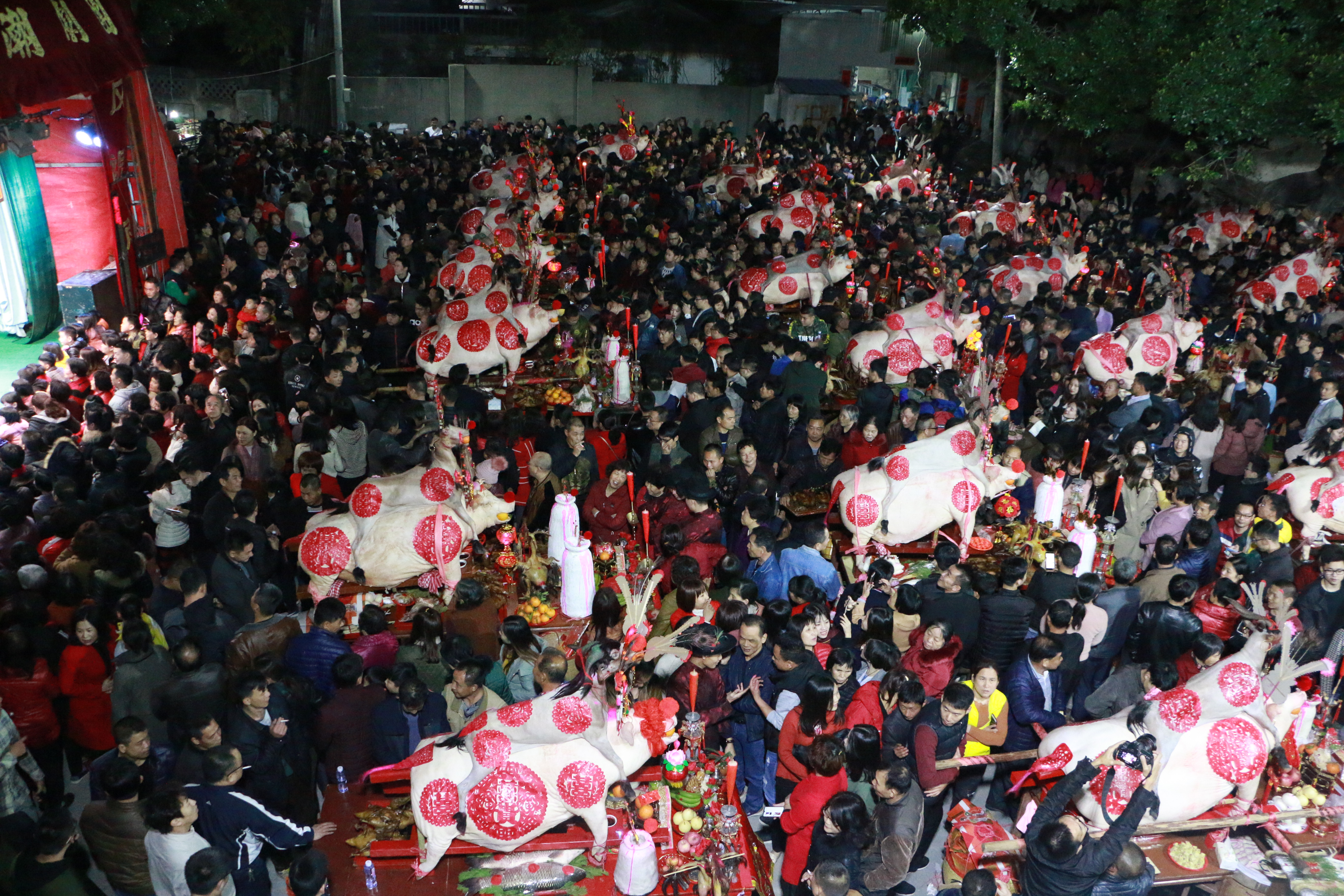
摆大猪
Display the Pig
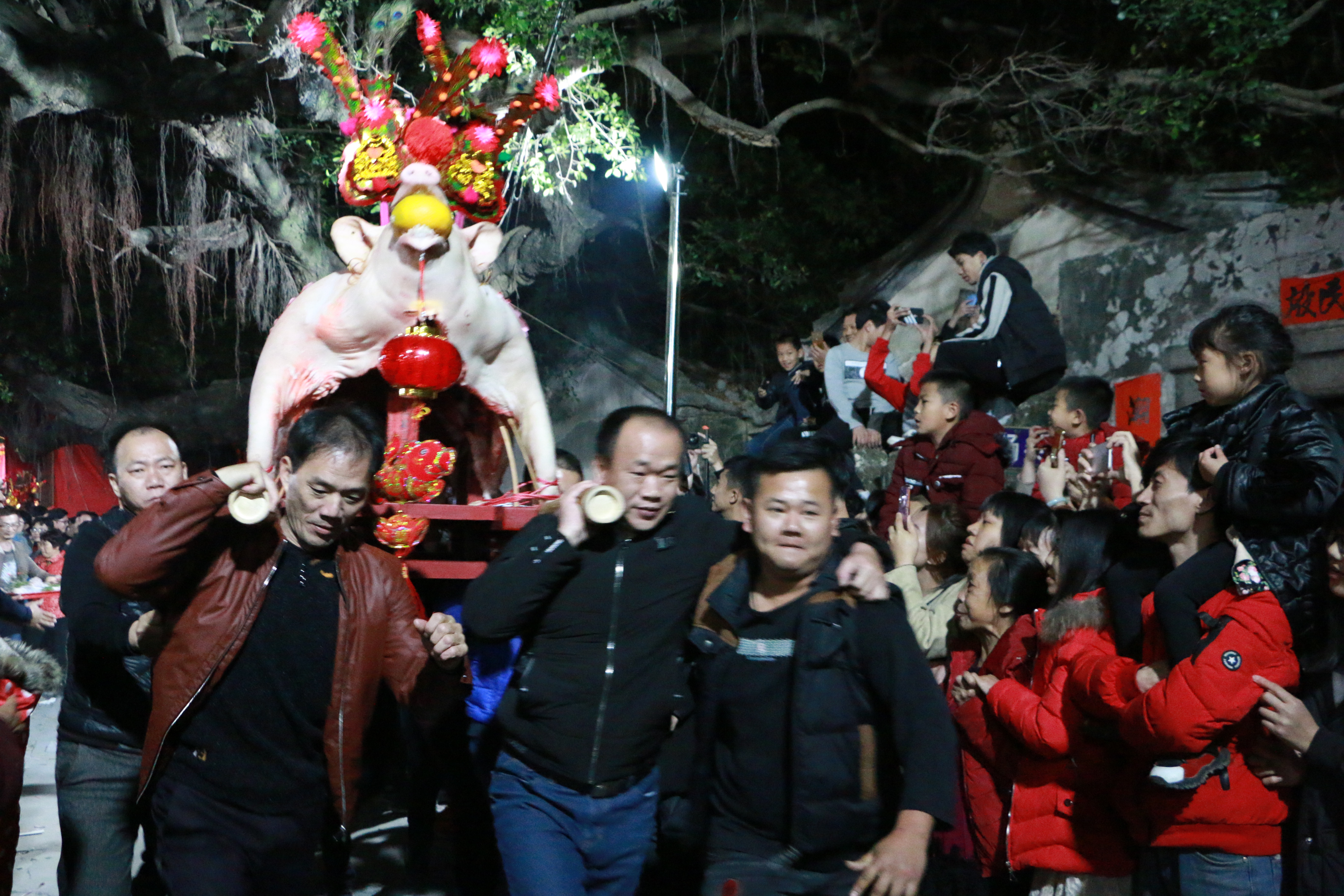
赛大猪
Sai Da Zhu
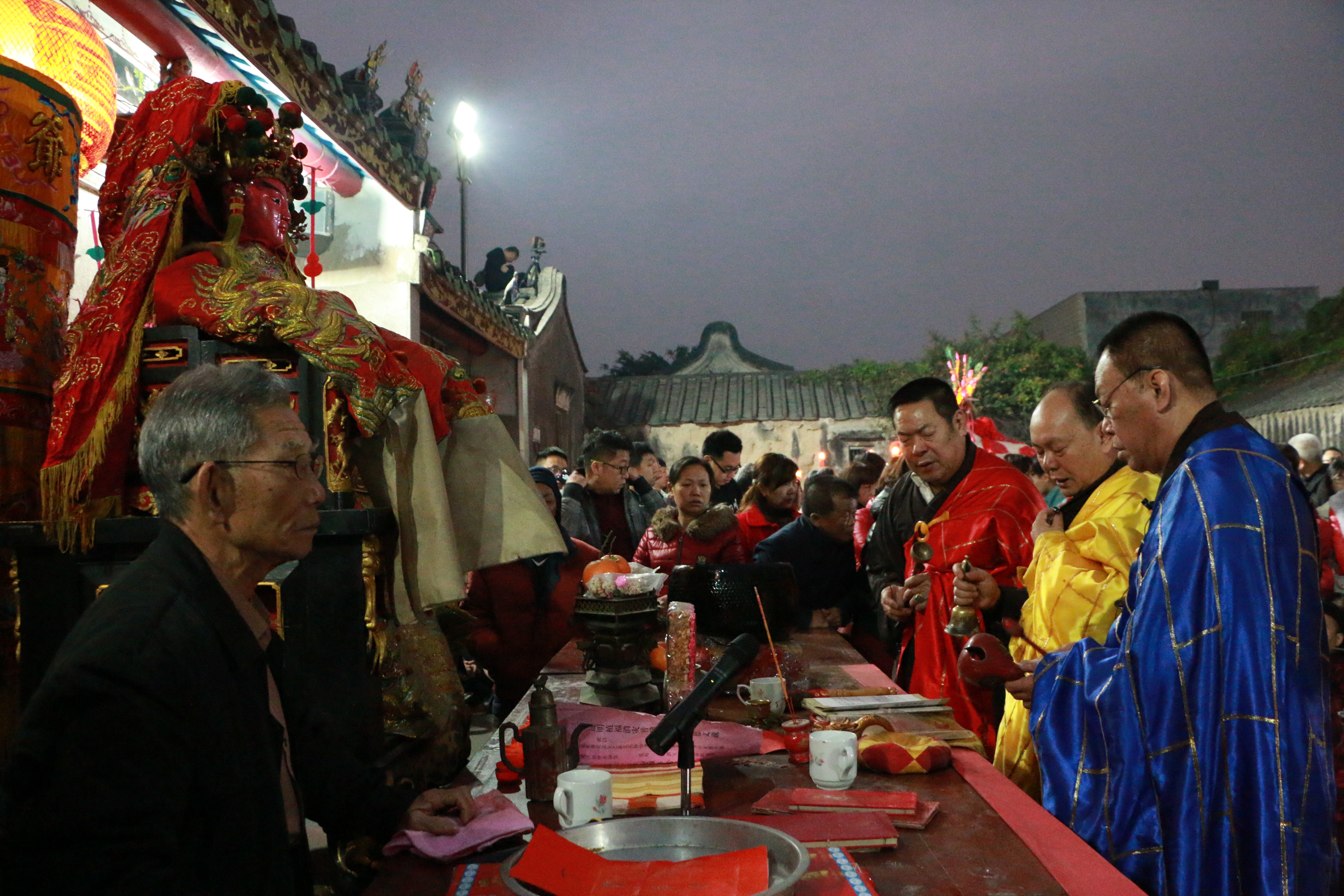
诵经
Chanting
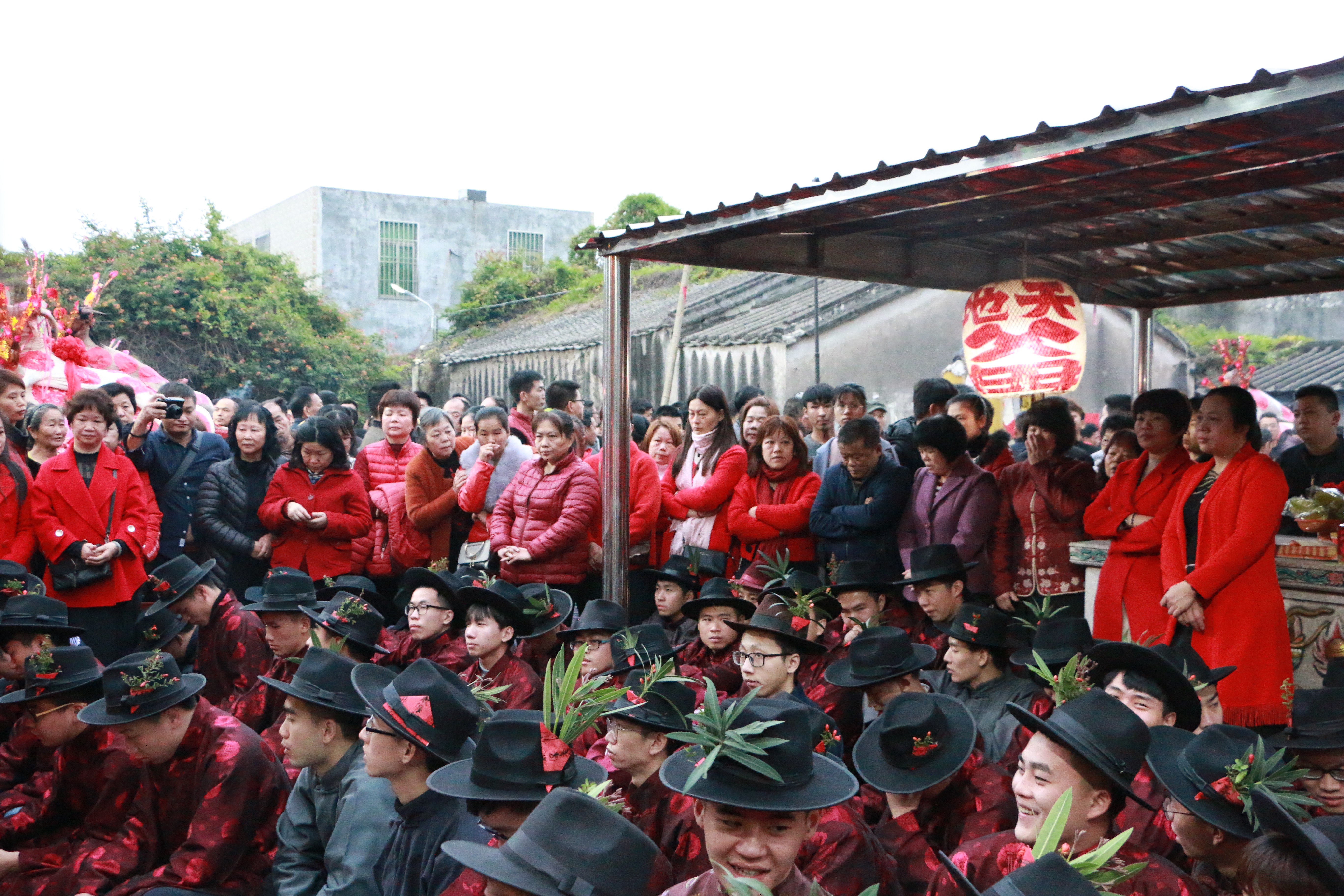
成人礼仪式
A Coming-of-Age Ceremony